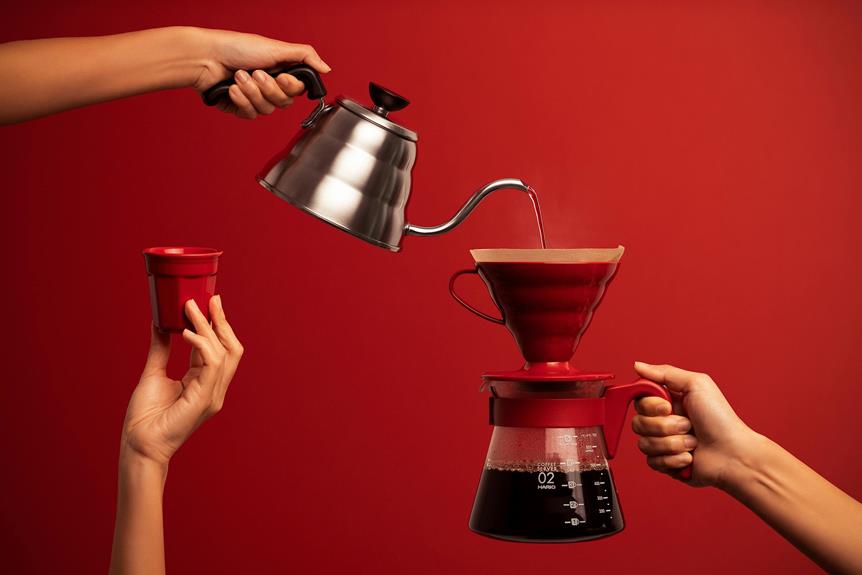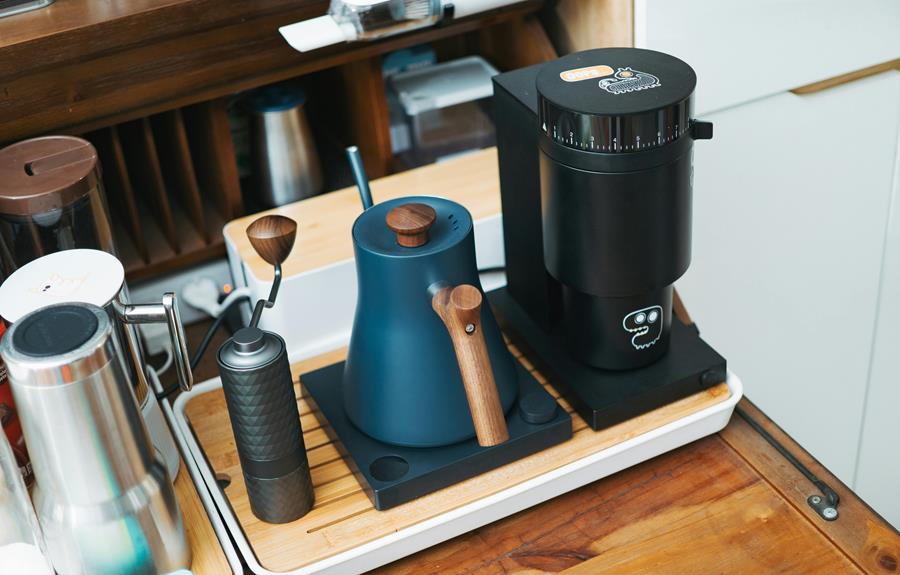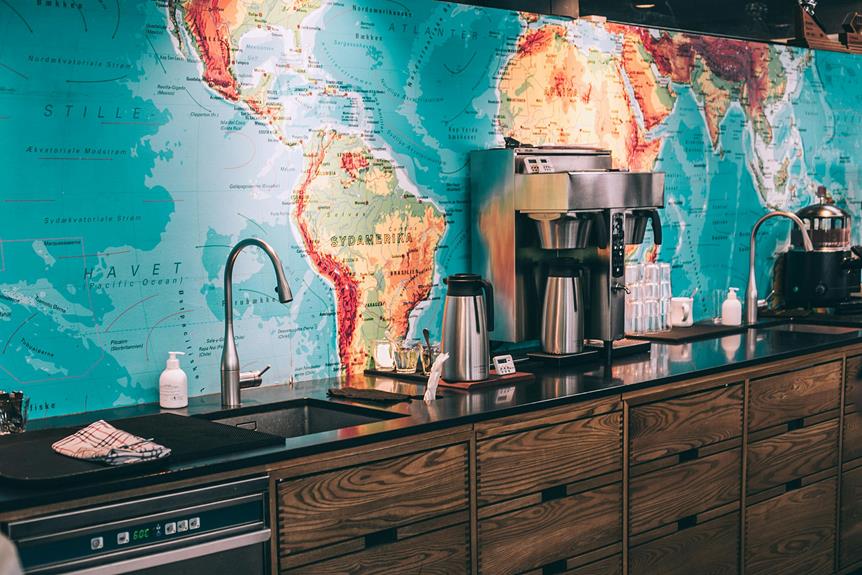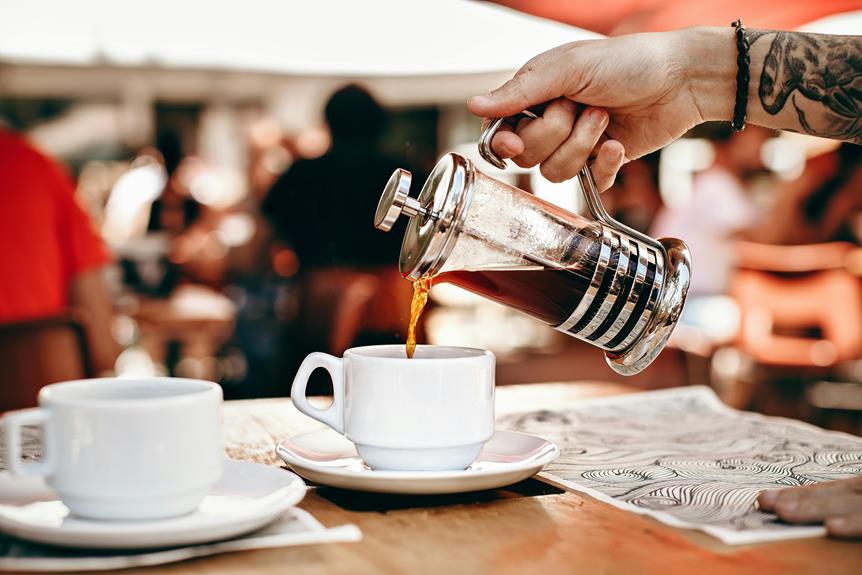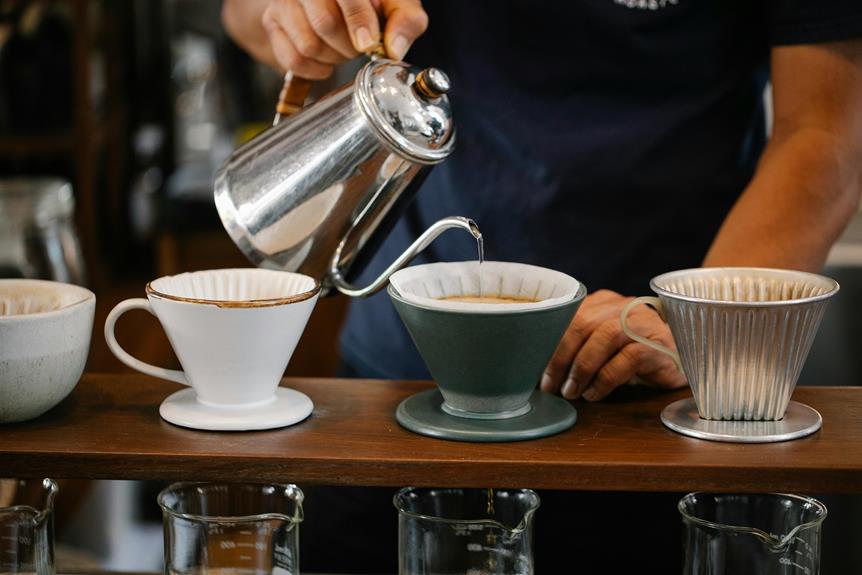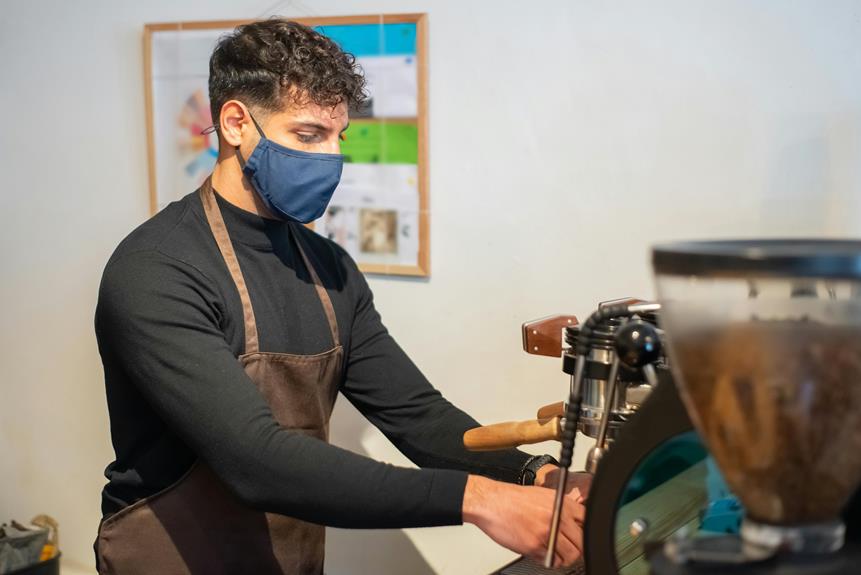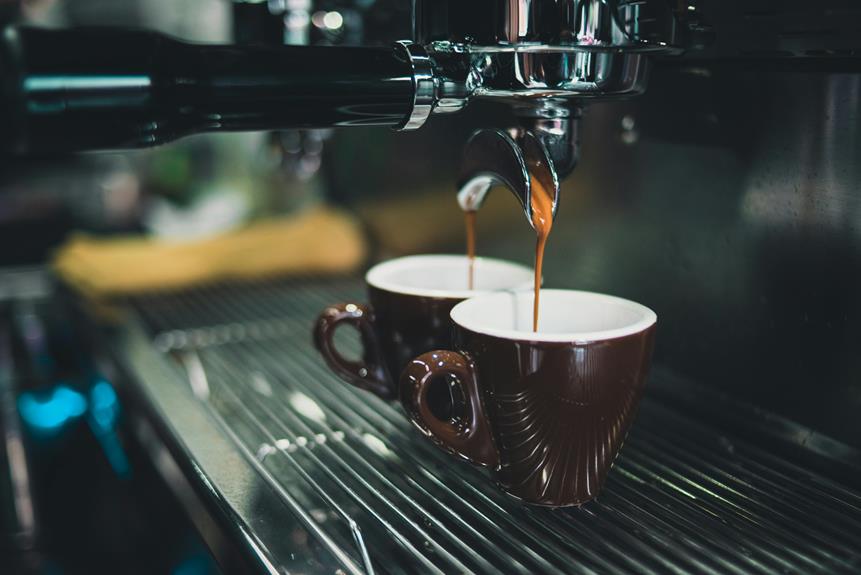You're about to tap into the full flavor potential of your Hario V60 by mastering the art of brewing coffee. Start by selecting high-quality coffee beans that suit your taste preferences, considering origin and roast level to get the desired flavor. Invest in essential equipment like a coffee grinder, kettle, and scale. Then, follow a step-by-step brewing process, grinding your beans just right, measuring coffee and water with precision, and mastering pouring techniques. With these basics down, you'll be well on your way to crafting the perfect cup. Now, get ready to refine your skills and uncover the nuances of your Hario V60.
Key Takeaways
- Invest in high-quality coffee beans that suit your taste preferences and consider origin and roast level for desired flavor.
- Use a coffee grinder to freshly grind beans, and a kettle to heat water to the ideal temperature of 195°F to 205°F.
- Aim for a coffee-to-water ratio of 1:15 to 1:17, and measure with a digital scale to achieve precise results.
- Pour water over coffee grounds in a circular motion, allowing coffee to steep for 45 seconds to 1 minute, and then strain and serve.
- Regularly maintain your equipment, including the coffee filter, to prevent buildup or residue and ensure a perfect brew.
Choosing Your Coffee Beans
Select a high-quality coffee bean that suits your taste preferences, as it's the foundation of a great cup of coffee.
When choosing your beans, consider the origin and roast level to get the flavor you desire. Beans from different regions have distinct flavor profiles, so think about what you like. Do you prefer bright and fruity notes from African beans or rich and smooth flavors from South American beans? Maybe you're unsure, and that's okay! Experiment with beans from different origins to find your favorite.
Next, think about the roast level. Do you like a light roast with a bright, acidic taste or a dark roast with a rich, bold flavor? Lighter roasts bring out the coffee's natural acidity, while darker roasts have a deeper, more caramel-like flavor. You might prefer a medium roast that balances the two.
Whatever you choose, make sure it's freshly roasted and has a good reputation. Your taste buds will thank you. By selecting the right bean origin and roast level, you'll be well on your way to brewing a delicious cup of coffee with your Hario V60.
Equipment You'll Need
You'll need a few essential tools to brew coffee with your Hario V60, including a coffee grinder, a kettle, and a scale.
The coffee grinder is essential for freshly grinding your beans just before brewing, which results in peak flavor. A kettle is necessary for heating water to the ideal temperature for brewing. A scale is imperative for measuring the coffee-to-water ratio, which affects the flavor profile. Make sure your scale has high scale accuracy to guarantee consistent results.
Regular Filter Maintenance is also important to prevent any buildup or residue from affecting the taste of your coffee.
Rinse the filter with hot water before each use and occasionally soak it in warm soapy water to remove any oils or residue. Additionally, you'll need a coffee filter, which usually comes with the Hario V60.
With these tools, you'll be well-equipped to brew delicious coffee with your Hario V60. Remember to handle your equipment with care, as they can greatly impact the quality of your brew.
Step-by-Step Brewing Process
How precisely do you measure out the ideal coffee-to-water ratio, a crucial step in the brewing process that can make or break the flavor of your coffee?
Aim for a coffee-to-water ratio of 1:15 to 1:17. For a 30-ounce brew, that's about 30-34 grams of coffee for every 450-480 grams of water.
Heat your water: Bring fresh water to a boil, then let it cool for about 45 seconds to reach the ideal temperature.
Measure and pour: Measure out your coffee and water, then slowly pour the water over the coffee grounds in a circular motion.
Steep and wait: Allow the coffee to steep for about 45 seconds to 1 minute, depending on your desired brewing pace.
Strain and serve: Remove the filter, and your freshly brewed coffee is ready to be poured and enjoyed!
Grinding Your Coffee Beans
Grind your coffee beans just before brewing to maximize flavor and aroma, as pre-ground beans can sit on a shelf for weeks or months, losing their potency. Freshness matters when it comes to coffee, and grinding your beans just before brewing guarantees you get the best possible taste.
When it comes to grinding, you'll need a grinder that can produce a consistent grind size. You have two main options: blade grinders and burr grinders. Blade grinders are inexpensive but can generate heat, which can damage your beans.
Burr grinders, on the other hand, are a better investment for coffee enthusiasts. They produce a consistent grind and don't generate heat, preserving the flavor and aroma of your coffee. There are two types of burr grinders: wheel burr and conical burr.
Wheel burr grinders are faster and more affordable, while conical burr grinders are more precise and durable. Regardless of the type, a burr grinder is essential for achieving the perfect grind for your Hario V60.
Measuring Coffee and Water
Now that your coffee beans are freshly ground, it's time to measure out the perfect amount for your Hario V60 brew. Measuring coffee and water is crucial to achieving the ideal flavor profile.
You'll want to aim for a coffee-to-water ratio of around 1:15 to 1:17. This means for every 1 gram of coffee, you'll use 15-17 grams of water.
Use a digital scale: It's essential to measure your coffee and water with precision to ensure consistency.
Experiment with coffee ratios: Find the perfect ratio for your taste preferences, but remember that 1:15 to 1:17 is a good starting point.
Monitor water temps: Ideal water temperatures range from 195°F to 205°F for optimal extraction.
Use filtered water: Use fresh, filtered water to prevent any impurities from affecting the taste of your coffee.
Pouring Techniques to Master
You'll need to master the pouring techniques to evenly saturate the grounds and achieve a balanced extraction.
This is where the magic happens, and your coffee starts to take shape. To begin, hold the kettle at an angle, allowing the water to flow in a circular motion over the grounds. This allows all the coffee to be saturated uniformly, preventing channeling and bitterness.
As you pour, use a pulse pouring technique, where you pour in short, deliberate pulses, pausing briefly between each pulse. This helps to evenly distribute the water and prevent the coffee from becoming over- or under-extracted.
Start at the center of the V60 and work your way outwards in a spiral motion, making sure to cover the entire surface. Don't pour too quickly, as this can cause the water to flow too fast and lead to an unbalanced extraction.
Take your time, and you'll be rewarded with a beautifully balanced cup of coffee. With practice, you'll develop the skills to pour like a pro and tap into the full flavor potential of your coffee beans.
Steeping and Waiting Times
When brewing with a Hario V60, getting the steeping and waiting times right is vital to achieve the perfect balance of flavors.
Initial Coffee Blooms: 45 seconds to 1 minute – This allows the coffee to release its CO2 and starts the extraction process.
First Pour Waiting Time: 1-2 minutes – Wait for the coffee to 'bloom' before pouring the rest of the water.
Total Steeping Time: 3-4 minutes – This allows for the ideal extraction of flavors and oils from the coffee grounds.
Flavor Peaks: 3.5-4 minutes – This is when the flavors are most balanced and the coffee is at its best.
Common Mistakes to Avoid
When brewing with a Hario V60, improper techniques can lead to unbalanced flavors, and knowing what common mistakes to avoid is essential to achieving the perfect cup.
One mistake is using water that's too hot, which can burn your coffee and give it a bitter taste. Make sure the water is between 195°F and 205°F for ideal extraction.
Another mistake isn't using the right coffee-to-water ratio. If you're using too little coffee, your brew will be weak, and if you're using too much, it'll be overpowering. Aim for a ratio of 1:15 to 1:17.
You should also avoid pouring the water too quickly, as this can cause channeling and lead to an under-extracted brew. Take your time, and pour in a circular motion to evenly saturate the grounds.
Experimenting With Flavor Profiles
Your Hario V60 is a versatile brewing tool, and experimenting with flavor profiles allows you to coax out unique characteristics from your favorite coffee beans.
By tweaking brewing parameters, you can discover hidden flavors and aromas that will take your coffee game to the next level.
Play with grind size: A finer grind can bring out brighter, more acidic notes, while a coarser grind can result in a smoother, more balanced cup.
Adjust the water temperature: Experiment with water temperatures between 195°F and 205°F to find the sweet spot for your beans.
Try different coffee-to-water ratios: A 1:15 ratio can result in a lighter, more delicate flavor, while a 1:10 ratio can bring out bolder, more intense notes.
Explore different roast levels: From light and fruity to dark and smoky, roast exploration can open up a world of flavor possibilities.
Consider using Flavor Wheels to identify and record your flavor profiles, and don't be afraid to try new roasts and brewing techniques.
With practice and patience, you'll develop a keen sense of taste and be able to coax out the perfect flavor from your Hario V60.
Frequently Asked Questions
Can I Use a Hario V60 With a Smaller Coffee-To-Water Ratio?
You can experiment with a smaller coffee-to-water ratio, but be aware that it'll impact your flavor profile. With a Hario V60, you'll want to balance ratio and water temperature to avoid over-extraction and bitter notes.
Is It Necessary to Preheat the Hario V60 Before Brewing?
You're wondering if preheating the Hario V60 is necessary. Yes, it's essential for ideal temperature control and thermal retention, ensuring a consistent brew. Preheat it with hot water to around 200°F to get the best flavor out of your coffee.
Can I Brew Tea or Other Beverages With a Hario V60?
You've wondered if the Hario V60 is a one-trick pony. Investigating the truth, you'll find it's not just for coffee! You can definitely brew tea or other beverages with it, exploring tea infusions and a world of beverage options.
How Often Should I Clean and Descale My Hario V60?
You should clean your Hario V60 every 3-6 months to prevent lime buildup and scale formation. Regular descaling helps maintain flavor and prevents damage, so make it a habit to check and clean your V60 regularly!
Can I Use Paper Filters With a Metal Hario V60?
You can definitely use paper filters with your metal Hario V60, but be picky about filter types and paper quality; thicker, high-quality filters will prevent paper taste and guarantee a smooth brew.
Conclusion
As you perfect your Hario V60 brewing skills, think of yourself as a master gardener, nurturing a delicate flower.
With each pour, you're providing the necessary nourishment for your coffee to bloom.
Don't rush the process, and remember that patience is the fertilizer that yields a rich, flavorful cup.
With time and practice, your coffee will flourish, and you'll be sipping on a masterpiece that's uniquely yours.
